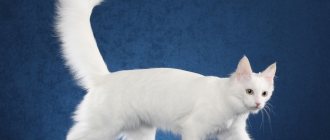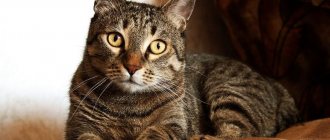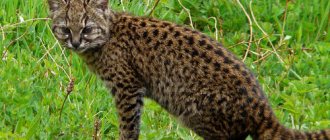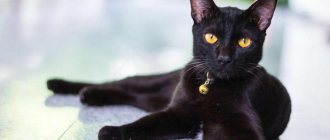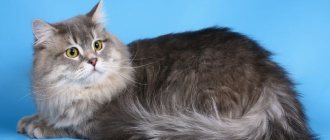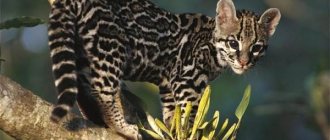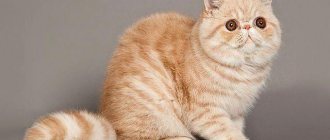History of the origin of the breed
The first representative of the hybrid breed Caracat appeared as a result of an accidental love affair between an ordinary Murka and a Caracal, a wild inhabitant of the steppes. This meeting took place at the Moscow Zoo in the 90s of the 20th century. Two months later, a charming little boy with tufts on his ears was born. The general public very soon learned about the precedent, but no one began to breed a new breed.
Caraquetas inherited their exotic appearance from their caracal father.
The story continued in the first decade of the 21st century in the United States. Joy Geisinger achieved the greatest success by crossing a male caracal with a domestic Abyssinian cat. The breeder’s efforts were appreciated by the international felinological organization TICA, but after her death, breeding work was suspended.
A little later, scientific research was resumed in Russia: Irina Nazarova, a felinologist and owner of the Krasnodar nursery KATALEYA, began to work closely on breeding caraquets and in 2020 received the third generation of kittens.
Today the breed is recognized only by the International Cat Union (ICU). However, breeding work is still ongoing, because the infertility of male hybrids up to the fourth generation remains a significant and unresolved problem.
Sometimes you can find information on the Internet that TICA (International Cat Association) recognizes Caraquets as an experimental breed, but there is no such information on the official website of the felinological organization.
What does a caraquet look like?
One litter can contain from one to five caraquet kittens, the weight of a newborn animal is at least 115 grams. Even blind babies have funny, almost horizontal ears, black on the outside. At this age, there are no tassels; the breed is identified by spots on the belly and paws. After two weeks, little caraquets open their eyes, and by the 25th day of life they are well on their feet and taking their first steps. By a month, the size of the kitten’s ears doubles, and small tassels up to 0.5 centimeters long begin to grow from their tips. At this age, the cat looks more like its wild ancestor with almond-shaped eyes of a rich honey or blue-green color.
From the age of one month, kittens begin to grow tufts on their ears and they become more and more similar to their wild parent.
As the caraquet matures, its color changes, the spots on the body become lighter, and the soft, pleasant-to-the-touch coat acquires a uniform color. Most often, the color of the animal is bright, deep and rich, from peach to red, which gives the large cat an even more wild look. The animal has a beautiful, proportionate, muscular body and fluffy strong paws, making the grace with which the cat moves unique. The caraquet can make long and precise jumps over a distance of up to 2 meters. All representatives of the breed have a physiological feature that refers the cat to its wild ancestors - a fatty fold on the stomach, the same as that of a caracal.
Caracats have a very bright and rich coat color in shades of orange, which makes them visually more wild.
The weight of an adult cat can reach 15 kilograms; on average, a caracat weighs 9–12 kilograms, while the height of the animal at the withers can vary from 40 to 55 centimeters. The length of the body reaches 90 centimeters, and if you measure the cat from the tip of the nose to the tail, it can be about 130 centimeters. An adult animal has a large body with a small head, on which large ears are located high, light on the side of the auricle and dark on the outside. Hybrid cats have expressive eyes and a wide nose with a large lobe, which may have a light spot on it. The tail and paws often have black horizontal stripes that blend in with the coat color in a gradient.
The caraquet has horizontal stripes on its paws and tail, smoothly blending into the main color of the coat.
Appearance of caraquet
According to the international ICU standard, a caraquet must have:
- strong, flexible and muscular body, reaching 1 meter from nose to tip of tail;
- weighing from 10 to 15 kg and height up to 50 cm at the withers;
- high, strong and proportional paws with dark pads;
- tail of medium length, wide at the base and gradually tapering to a rounded tip with darkening;
- fat fold in the groin;
- long and strong neck;
- a wedge-shaped head with smooth transitions;
- convex forehead;
- a wide chin without protrusions or bevels;
- large, pointed, high-set ears, covered on the outside with short black hair, decorated with white brushes on the inside, and tassels at the tips;
- a wide and convex nose of a dark color (a pink middle is also acceptable);
- large amber or green almond-shaped eyes, outlined with a dark line against the background of light “glasses”;
- dark marks above the eyebrows, on the cheekbones, whisker pads and black “tears” coming from the inner corners of the eyes;
- short, thick and soft wool of medium length with ticking - lighter at the base and darker at the tips;
The belly, chest and inner side of the paws of the Caraquet are lighter in color with spots; white hair should only be around the eyes and on the chin
- one of four types of color: wild - with black marks on a red-brown background;
- chocolate - with brown spots;
- cinnamon - red-brown markings on a peach background;
- silver - reminiscent of the color of a snow leopard.
The most striking resemblance to the caracal is found in the first generation (F1). They inherit 50% of their father's genes. Subsequent individuals increasingly take on their mother's traits and even decrease in size, but the color of their fur and the tufts on their ears remain their unchanged attributes.
Characteristics, breed standard Caracat
The Caracat today is one of the brightest, most beautiful, large and expensive hybrid cats. He is a worthy competitor to the legendary Savannah, you can also read about her on the Mister Cat website.
An adult male can reach a weight of 15-17 kg or even more, has a beautiful, athletic body, large dimensions, which are sometimes only slightly less than the size of the Caracal or even equal to them.
This is an animal with excellent physical shape, which has also adopted a calm and non-conflict character from the Caracal, so all felinologists in the world are very interested in the further development of this breed.
If we talk about the Caraquet breed standard, it still exists only in preliminary form, since even the fourth generation of animals has not been obtained. However, it is as follows:
- The first external assessment is an elegant appearance, original color, wild appearance.
- Dimensions - a large animal up to a meter in length, weight about 15 kg, height at the withers up to half a meter.
- The head is a wedge-shaped modification with rounded transitions; it does not have “chopped” contours or flat surfaces. The frontal part of the skull is wide and slightly more convex. The lower jaw is not excessively heavy, but well defined, and cannot be small or slanted. The maximum score for the head is 5, for the muzzle – 6 points.
- The nose is large, wide, with a “wild” convex shape. It can be pinkish or brick with a dark outline, or completely black.
- The eyes are large and expressive. The shape is almond-shaped. They cannot be too round or slanted. Has a dark and white outline. If there is a clearly defined wild “tear trail” running towards the nose from the inner corner of the eye, such an animal is valued higher. The maximum score is 6 points.
- The ears are set high and wide, large, and have practically no forward tilt. They end in black tassels, but the further the generation goes, the lower the likelihood of their presence. The auricle is evenly pubescent outside and inside, the back part is dark. They are rated on an eight-point scale.
- The body is of medium length, with well-defined, but not prominent muscles. The chest is quite wide, on the belly there is a well-formed fat fold, characteristic of Caracals. The neck is of medium length, strong. The maximum score is 15 points.
- The limbs are quite high, but proportional to the body, the muscles are well developed. The paw is wide, the toes are oval. They are scored accordingly by 5 points.
- The tail is wide and powerful at the base, tapering slightly to a rounded black tip. Has no markers or rings, and is generally longer than the Caracal but shorter than any other domestic cat. Scored up to 5 points.
- The coat is dense and shiny, soft to the touch, with undercoat. Texture and length are scored 5 points.
- The color is ticked, each hair can have two or three color rings, and they alternate with lighter areas. A stripe of a darker shade may run along the ridge line. The face welcomes the original “mask” of the Caracal – dark “tear tracks”, eye rims, markers on the areas of the brow ridges and ear pads. Markings may be on the stomach. Lighter hair in the abdominal and chest areas and on the inner surface of the paws is highly valued. The limbs may have ring stripes, but they must be open. Coat color tones range from reddish, Sorel-type, to cooler and grayish, as well as charcoal, chocolate and cinnamon. It is valued at 35 points, of which 10 are for ticking, the same for markings, 10 for color and 5 for the tones of the iris. It can be golden or greenish tones.
- Acceptable faults include closed ring markings on the limbs, tail, “medallions” and “necklaces” on the chest area, too cold and gray color colors, lack of black marks on the outside of the ears.
- An animal is disqualified for a bright white “medallion” on the chest and anywhere except the lower jaw and eyeliner, a defect in the tail, the presence of spots and stripes even in a residual form on the body, a gray tone of the lower layer of the coat, polydactyly, unacceptable and unrecognized colors.
- Permitted crossings until the final type has been established are allowed with Caracals, Abyssinian cats, Orientals, Serengetti, Bengals and any other breeds of domestic animals, if this is necessary to obtain wealthy offspring and improve breed qualities.
Caracal
All Caracats have excellent physical shape, quick reaction, and are able to jump in height and length up to three meters. The presence of fat reserves in the abdominal cavity makes these animals very hardy; they can go without food for a long time, even up to three days without water. As a legacy from the Caracals, these cats received excellent hearing, acute vision, a natural sense of smell and all the makings of twilight and daytime hunters.
The final color options for the Caraquet have also not yet been established. Animals can be light sandy shades, chocolate, reddish tones, even black and silver. Tabby in any areas except the belly and paws, as well as dirty gray tones, are unacceptable. Melanism (much darker coat, even black) is possible in Caracals and therefore their descendants can adopt this feature.
Currently, it is generally accepted to divide colors as follows:
- Wild - the main background is reddish-brown, the markings are black and white.
- Cinnamon - peach background and brown-red markings.
- Silver – it can be compared to the colors of snow leopards.
- Melanistic – black, chocolate.
Character of the caraquet
Despite the wild blood flowing in their veins, Caraquets have a fairly flexible, balanced and affectionate disposition, although they are not without some independence. They are very inquisitive, energetic, love outdoor games, exhibit a pronounced hunting instinct, prefer to be nocturnal, but can adapt to the regime of family members.
Caraquetas do not like loneliness - they need company, but they tolerate changes of environment - car rides, walks in nature, moving - easily. The exotic pet will have the warmest relationship with its owner. Like a devoted dog, he will accompany him everywhere and participate in household chores. The caracat shows its love by massaging its owner with its paws, licking him, butting him, and “chirping” in response.
Caraquet kittens adopt behavior and communication skills from their mother, a domestic cat.
For small children, such an animal is not at all dangerous; it has no tendency to aggression. However, if you test his patience too persistently, then, like any cat, he is capable of using his claws. The caraquet perceives strangers warily, and may even hiss, defending its possessions.
Domestic “lynxes” are distinguished by a sharp mind, are easy to train - they love to carry various objects in their teeth, easily remember their nickname and respond to it. In everyday life, with proper upbringing, there will be no problems with this cat: she will not do dirty tricks or destroy property and will quickly understand what a tray and scratching post are for.
Animal character
One very interesting feature of caracats is that these cats do not know how to make the usual “meow”, instead they snort, whine, hiss and squeak very gently. Little kittens almost immediately begin to actively “talk”, making squeaking sounds when they are completely safe and hissing when something scares them. A new toy, a stranger or another pet can make a baby caraquet afraid, but cats of this breed quickly adapt to new conditions and, making sure that nothing threatens them, continue the game. Even small kittens have very sensitive hearing, which determines their character; they can distinguish the most insignificant noises at a distance of up to 60 meters.
Despite their hunting skills and passion for active games, caraquets are friendly and are not capable of aggression outside the game. Like the familiar domestic cats, caraquetas are very affectionate, they love attention and can come for a portion of love without an invitation. They happily sleep on their owner, knead their paws, rub and purr when they like something. Although personality largely depends on the individual cat, friendliness is a typical trait of the breed. When a stressful situation arises, the caracat can come to the defense of its owner or one of the family members, baring its claws and making hissing sounds.
Generally speaking, these are obedient, very intelligent animals that are excellent for family life. They get along well with small children and other pets as long as there is no aggressive behavior towards them. Another interesting feature of this breed is that cats move very quietly, and not only when playing.
Video: Caraquet kittens playing by the pond
Health
Due to the youth of the breed, it is too early to talk about any genetic diseases inherent in it. It is believed that caraquets inherited excellent immunity and excellent health from their wild father. Over 10 years of working on the breed, not a single case of infectious infection of caraquets has been identified, but it is better to play it safe and annually give your pet the necessary vaccinations against:
- panleukopenia;
- rhinotracheitis;
- calcivirosis;
- chlamydia;
- rabies;
- depriving.
Once every three months and before vaccination, it is necessary to carry out deworming, selecting the dose of the drug depending on the weight of the animal
It is unknown how long the life of a caracat is, but their father, the caracal, lives on average up to 18 years at home.
Breed health
Healthy, definitely healthy! This is what a veterinarian will say about a caraquet cat, because practically no deviations are inherited. But the breed is experimental, so it’s too early to talk about absolute health.
Immunity is high, but this does not exclude vaccination, everything is the same as in ordinary cats, including anthelmintic treatment.
Optimal living conditions for caraquets
Despite their wild roots, caraquets can be kept in a city apartment. However, a large, active, jumping cat (up to a height of three meters) needs space, so a country house would be an ideal option for such a pet. The caracat will be grateful to the owners if they:
- they will provide him with toys - traditional mice, teasers, squeakers, as well as rubber balls, rings and dumbbells for dogs are suitable for this;
The most important criterion when choosing a toy is safety: you should avoid fragile materials, small parts and feathers that a caracat can swallow
- they will build a sustainable sports complex with tunnels, slides, and multi-level playgrounds;
- organize a “nest” for relaxation on a hill;
- place a spacious tray in a secluded place, away from the sleeping area and bowls of food;
It is preferable to choose wood or paper litter for the toilet - it will not harm the pet, even if it decides to taste it.
- Walking in the fresh air will be allowed.
If your pet regularly goes outside, then treatment for ticks and fleas will not hurt - special collars, sprays and drops on the withers will help.
It is necessary to walk a caraquet even in the local area on a harness, otherwise it may get too playful, jump over the fence and run away
Having brought a small caracat into the house, limit the geography of its movements to one room. Place a bowl, tray, bed and toys within walking distance, play with the kitten more, do not make sudden movements or make noise - all this will help him adapt faster to the new place.
Within a week, the kitten will fully adapt to its new family.
[edit] Character
According to breeders and owners of the Caraquet, this hybrid cat is distinguished by an affectionate and friendly disposition, special devotion to its owner, and curiosity. They have a lively temperament and a consistently balanced emotional state. They are involved in the life of the owner, happy to accompany him in any household (and not only) affairs. Responsive and capable of training, various games that are more typical for dogs (for example, fetching a thrown ball). Unlike the caracal, according to the owners, it is not prone to damaging furniture and other property in the house, and therefore does not require keeping in an enclosure. Organized and neat in his cat's life: he strictly follows the rules of the toilet and, with proper upbringing by the owner, does not violate other rules of conduct in the house (especially those related to food).
Nutrition
It is better to feed caracats with natural food. The diet should include:
- raw meat: quail;
- chicken;
- rabbit;
- beef
It is forbidden to treat carakets with pork, thermally processed foods, smoked meats, sweets and any other food from the master's table. Despite a naturally strong digestive system adapted for digesting skins and bones, improper nutrition can seriously undermine the health of a pet.
Kittens are fed minced meat heated to room temperature, giving it three times a day. From five months onwards, the diet of small predators includes meat cut into pieces. By this age, a young caracat is able to “persuad” three quails a day. Adult animals are fed 1–2 times a day, removing the leftovers after meals. The required daily amount of food is 5–10% of the pet’s body weight.
Video: a three-month-old caracat eats raw meat
Adult caraquets can be switched to industrial grain-free super-premium and holistic food:
- Acana (Canada);
- Carnilove (Czech Republic);
- Go Natural (Canada);
- Grandorf (Belgium, France);
- Farmina N&D (Italy, Serbia).
In the wild, in search of a source of water, caracals may not drink for 3–5 days, and they do not always manage to eat. The fat fold on the abdomen helps to survive a forced hunger strike - it stores reserves of nutrients. Caraquetas also have such a reserve, but when switching to dry food, make sure that clean water is always freely available.
Character and temperament
Caracats have an affectionate character, despite the presence of wild blood.
These cats are smart. They are obedient and enjoy playing games and love to move a lot. Such animals are energetic and inquisitive. They can stay awake at night, but not disturb family members' sleep. Even if the cat is not very tame at first, over time he will get used to you. In any case, such a pet will not show aggression. These are very peaceful and kind animals.
Grooming
In terms of care, the Caracat is no different from an ordinary short-haired cat.
Hypoallergenic and odorless wool is considered a pleasant bonus. However, this statement is very controversial, especially considering that allergies are caused by a special protein contained in the saliva, secretions and particles of animal skin.
Grooming
It is not difficult to maintain a presentable appearance of a caraquet fur coat:
- once a week to remove dead hairs, it is recommended to comb your pet with a rubber mitten, and in the summer - during the molting period - the procedure should be carried out daily;
- The cat should be bathed once every three months or as needed - the procedure will not cause problems, because caraquets love water very much and turn it into an object of play, but make sure that the water does not get into the ears; The following shampoos are suitable for short-haired cats: VEDA “Phytoelite”;
- Doctor ZOO;
- "BioVax";
- Ms. Kiss "Graceful Panther";
- Cliny “Nutrition and Shine”;
- AVZ Elite Professional;
- Rolf Club Keratin+ Shiny;
- Iv San Bernard Traditional Line.
Photo gallery: caraqueta coat care products
VEDA “Phytoelite” shampoo is created on the basis of a decoction of nettle leaves. “Doctor ZOO” shampoo with keratin and provitamin B5 improves metabolic processes in the skin. “BioVax” shampoo contains natural ingredients - extracts of rose hips, St. John’s wort and tea tree oil. Shampoo-conditioner Ms. Kiss “Graceful Panther” effectively nourishes and soothes the skin, strengthens hair follicles and restores the structure of hairs Cliny shampoo-conditioner “Nutrition and Shine” contains mink and grape seed oil, therefore it nourishes, restores hair and gives it shine Thanks to natural ingredients, AVZ Elite Professional shampoo effectively restores hair structure Rolf Club Keratin+ Shiny Shampoo contains a keratin complex that will give the coat elasticity, shine and volume Iv San Bernard Traditional Line Shampoo for dogs and cats with lemon aroma moisturizes the skin and prevents the formation of dandruff
Nail care
The caraquet must be provided with a durable scratching post, for example, made from sisal, a coarse natural fiber that is durable and harmless. With flimsy corrugated cardboard devices, large and strong cats will be dealt with quickly. In addition to this, once every two weeks it is necessary to shorten your pet’s claws, for example, using a nail clipper-secateurs that has a protective stop.
Claws should be cut at an angle of 45°, 2 mm away from the pulp, which is rich in blood vessels.
Some owners declaw cats, but this is inhumane and is equivalent to amputating the upper phalanges of a person's fingers along with their nails. In fact, the animal will become disabled: it will not be able to hunt, climb to heights, jump, maintain balance, it will become clumsy and defenseless, which will negatively affect its psychological state.
The caraquet's claws are retractable, and with proper training the animal will not damage furniture or scratch itself during games.
Many owners purchase anti-scratch guards for their pets - a newfangled accessory that allows them to protect furniture and hands from damage. The material of the caps and the medical glue with which they are attached are completely safe for the animal, but not everything is so rosy:
- anti-scratch pads can cause discomfort - the cat will not be able to catch its claws if it decides to climb to a height, and this is dangerous;
- the pet’s gait may change, because the claws will constantly remain extended;
- Deformation of the claws and the occurrence of inflammatory processes cannot be ruled out.
Ear cleaning
A caracat's ears should be examined once every six months. The process will not take much time:
- you need to play with the animal or calm it down with stroking;
- fix it and turn the ear out;
- swipe with a dry cotton pad, removing dry dust - movements are made outward;
- repeat the procedure with a clean cotton swab dipped in warm boiled water.
You cannot clean the ear canals with cotton swabs - you can damage the eardrum. If there is discharge, plaque, or an unpleasant odor, you should contact a veterinarian.
Eye cleaning
You need to wipe the eyelids of a caracat with a soft cloth soaked in strong tea leaves, chamomile infusion or warm boiled water. Movements are carried out from the outer corner of the closed eye to the inner. Excess liquid is blotted with a dry cloth.
You should not touch the animal's eyeball - the delicate cornea is easily damaged. The presence of purulent discharge should alert you and be a reason to contact a veterinary clinic.
Dental care
Caraquetas that eat raw meat or dry food do not need to brush their teeth. They do not have time to form tartar due to natural cleansing and massage of the gums.
Caraquet care
Caracats are cared for in the same way as regular house cats. This active animal loves to play, run and jump, so it is necessary to provide the pet with space for play, a large multifunctional play set and a variety of toys (intended for dogs - without feathers or loose parts).
A large gaming complex is necessary for a mobile and active caraquet
It is very important that only high-quality and durable materials are used in finishing toys. Anything that is poorly sewn or glued will definitely be torn off by the cat. Toys should be varied so that the pet can choose what he likes. They need to be changed periodically.
In the first few days after purchasing a kitten, it is recommended to keep it in a limited space (room), where you need to place a bed, tray and bowls. Adaptation usually takes 5–7 days, then the baby can be released into other rooms.
Nutrition
The feeding area should not be located next to the bed or toilet. Leftover food should not be left in the bowl; as soon as the kitten leaves the plate, the food should be removed immediately. The daily amount of food is taken at the rate of 5–10% of the pet’s weight. Small kittens and adolescents up to 1 year old are fed twice a day; an adult animal needs one feeding per day. The animal's diet should consist mostly of meat.
Feral cats should only be fed meat
The following diet is recommended for Caracats:
- lean veal and beef;
- duck;
- rabbit;
- horsemeat;
- elk meat, venison;
- chicken heads;
- quail (gutted and plucked);
- raw quail eggs;
- chicken heads.
It is forbidden to feed cats food from the common table, fatty pork, chicken eggs, tubular bones and entrails (liver, lungs, etc.).
Experienced breeders recommend feeding caraquets freshly killed game (bird, rabbit). Meat products must first be thoroughly frozen, and then immediately defrosted and filled with hot water immediately before feeding. The food should be slightly warm.
It is necessary to ensure the constant availability of clean drinking (filtered, bottled) water in the drinking bowl, which should be changed daily.
In terms of nutrition, you should follow the recommendations received from the breeder. According to a friend who owns a serval, such animals should be fed exclusively with meat. Under no circumstances should they be given regular food from human kitchens. The digestive system of wild animals is also not adapted to dry ready-made food. Improper nutrition almost immediately affects the appearance of the pet. The fur becomes faded and begins to fall out a lot. And the animal itself feels bad and is constantly nervous. It is possible that fourth or fifth generation caraquets will be able to eat like regular domestic cats. In the meantime, their menu is quite expensive for the owner.
Video: Caraqueta kitten eats meat
Toilet
Caracats are potty trained like regular cats; they understand very quickly and without any problems what is required of them. In most cases, the breeder gives away a pet that is already litter box trained. The toilet is installed in a quiet, secluded place where the cat will not be disturbed. It should be placed away from food bowls and resting areas. There should be no other animals or small children there.
Considering that individuals of this breed are distinguished by their rather large dimensions, the pot should be purchased large enough. But you need to take into account that it may be difficult and uncomfortable for a kitten to get into it at first. Therefore, over time you may have to purchase a larger container.
Any filler is suitable for carakets; they are not particularly picky in this regard. Kids are advised to sprinkle wood or paper pellets, as they are safer: even if the kitten swallows them, they will not cause him any harm.
Although any litter is suitable for caracats, for kittens it is better to choose natural wood
Caracats do not need to be constantly taken outside to relieve themselves, like, for example, other large wild cats. They are smaller in size and therefore can use a regular cat litter box. According to a friend, the serval had to be let out for a walk at least twice a day.
Appearance care
An important point is the care of the caraquet's coat. Once a week, your pet should be combed with a special rubber brush or mitten to remove dead hair. During the shedding period, which usually occurs in the summer, cats need to be brushed every day.
The caraquet's fur needs to be combed with a special plastic brush.
Washing animals unnecessarily is not often necessary; once every three months is sufficient. Representatives of this breed usually bathe with pleasure, as they are not at all afraid of water.
Once every 2-3 weeks you need to trim your nails using only special scissors. And you definitely need to provide your pet with a good and firmly secured scratching post. It is better to purchase designs using sisal, since the softer material is easily torn apart by a strong animal.
Approximately once every 10–14 days, it is necessary to inspect the ears and wipe them, if necessary, with a cotton pad moistened with warm water. There is no need to go deep inside with cotton swabs. If you suddenly notice any discharge or an unpleasant odor, you should immediately contact your veterinarian.
Eye care involves regularly removing accumulated dark plaque with a damp soft cloth, which is moistened in a special solution for washing the eyes or in warm boiled water. The presence of purulent or serous discharge from the eyes should be a reason to consult a doctor.
Walking
Unlike wild steppe lynxes, caraquetas do not need to be walked to relieve their natural needs; they can go to the toilet in a cat litter box. But they love to walk, because they are extremely curious and inquisitive.
You only need to walk your caraquet on a leash.
You only need to take your pet for a walk on a leash.
Features of mating and breeding of the caraquet
The main difficulty in breeding caraquets is the sexual impotence of males until the fourth generation. Only females take part in procreation. Males of other breeds are selected as partners for them:
- Abyssinians;
- orientals;
- Ocicats;
- Serengeti;
- Egyptian Mau.
It is optimal to breed caracats at the age of one and a half years and on the 3rd–6th day of estrus. Both partners must:
- look healthy and well-groomed;
- have the necessary documents - veterinary passport, pedigree, club card, evaluation sheets from exhibitions;
- undergo a veterinary examination;
- be vaccinated no more than a year and no less than one month ago;
- undergo parasite treatment a week before the expected event;
- have a fresh manicure so that in the heat of passion you don’t injure each other.
Before mating, a contract is drawn up, which specifies all the conditions, information about the producers, their owners and the date of the event. The “wedding” is held on the groom’s premises, and in order for the bride’s adaptation to go smoothly, you need to take her personal belongings (bowl, tray, bed) with you. The cat spends several days in the new place - as soon as the partner does his job, he will lose interest in her, because the female will lose her characteristic smell. Pregnancy will last from 65 to 79 days, and there will be 1-2 kittens in the litter.
Without harming its health, a cat can give birth once a year - it needs time to recover
An amateur should not breed an experimental caraquet breed - the help of a specialist from the nursery where the animal was purchased is required.
How much does it cost and how to choose a Caraquet kitten
This unique experimental breed is rightfully considered today one of the rarest and most expensive.
A first generation kitten costs 15 thousand dollars, sometimes even higher, 25-30. The second and third are a little cheaper, but as soon as full-fledged individuals of the fourth and fifth appear and the breed is fully approved, the price of these pets with the right to breed is unlikely to be lower, and may even increase at first. Standing at the origins of a new breed is always prestigious and it is a very expensive pleasure, which, however, with successful work can more than pay off.
The nurseries where it is now possible to order such a kitten can still be counted on one hand. These are, for example, “Kataleya” in Krasnodar, “Vip Karaket” in St. Petersburg, “Karaket-Angara” in Irkutsk, “Altai-Karaket” in Barnaul and “Vip-Leo”, specializing in breeding the most expensive wild and hybrid cats , in Kyiv.
Of course, all pets are released fully vaccinated, with veterinary passports and pedigrees, with constant recommendations for the maintenance and development of Caraquet. Moreover, while the experimental breed is in its infancy, breeders insist on maintaining close contact with the new owners of their graduates in order to collect complete information about the animals.
It is recommended to take the Caraquet kitten from the nursery no earlier than three, and preferably four months, so that he has time to learn independence and is not so dependent on his mother.
If you are choosing a baby of the first generation, then you should carefully consider its appearance. Usually, already at one month, the kitten grows characteristic black tassels on its ears; at this age they are about half a centimeter long.
From about the same age, babies learn to go to the toilet on their own and become familiar with the scratching post. By the end of the second month they are eating solid food well.
You should carefully monitor the baby's health; signs of a full-fledged pet are clean, clear eyes, absence of discharge from them, as well as from the ears and nose, shiny coat, active behavior, display of curiosity and friendliness towards people.
Castration of caraquets
If your plans do not include getting offspring, your pet needs to be castrated or sterilized, otherwise it will mark its territory, behave nervously, and may become seriously ill in the future. As a rule, the operation is well tolerated, and after a week the animal forgets about what happened. The right time for genital removal surgery is 8–11 months. The process of preparation and rehabilitation proceeds as follows:
- 30 days before surgery (no more than a year), the animal must be vaccinated, and two weeks - treated for parasites;
- within twelve hours before surgery, a fasted diet and plenty of fluids are required;
- immediately after the operation, you need to provide the pet with peace by laying it on a bedding located on the floor;
- it is important to put an Elizabethan collar or blanket on it (for 10 days) so that there is no threat of infection of the seams as a result of licking;
- you need to regularly treat the wound with Chlorhexidine and give painkillers (only on the recommendation of a veterinarian);
- In the first days, you should not put a strain on the caracat’s digestive tract, so it is better to give raw meat in the form of minced meat.
Young individuals purchased from a nursery not for breeding will already be neutered by the breeder.
[edit] Generations
An integral part of the concept of a hybrid cat is the so-called “generation”, denoted by the prefix F1, F2 and beyond.
Generation of a hybrid (including caraqueta) - or generation of a hybrid - means the “queue” of birth of a given individual in relation to the wild ancestor. The essence of the concept of generation is the ratio in a kitten (%) of the blood of a wild cat and a domestic cat. For example, the offspring of the first generation - F1 (F1) - has approximately 50% of the blood of a wild cat (caracal - in the case of caracat) and 50% of the blood of a domesticated individual. The generation of the next generation - generation F2 (F2) - occurs as a result of the birth of a kitten by an individual of the first generation, and such offspring already have 25% of the blood of a wild cat. The higher the value of the generation index (the numbers after the letter F (Ф)), the less wild blood there is in a given offspring and the more such offspring resemble a domestic cat in their appearance and size. It should be noted that the percentage of blood (50/50 for F1) in the offspring is approximate: in one litter there are from two to six kittens, and each of them “receives” either a slightly larger or smaller percentage of wild blood (caracal). For this reason, kittens, being from the same litter, may have a somewhat different appearance: usually this concerns the shape and color of the muzzle - a more rounded or more elongated shape, and the severity of the so-called “mask” of the caracal, the length of the tufts on the ears, weight and size. But of course, all these differences are not pronounced - in general, all caraqueta individuals have a decent “wild” appearance.
The concept of generating a caraquet hybrid is especially important for intrabreed work: firstly, to obtain an individual containing entirely only the blood of a caraquet (purebred individual), and to obtain a fertile male of this hybrid, since up to the fourth generation, male hybrids, including male caraquets, are considered barren. Therefore, females are of particular value in breeding hybrids, thanks to whom work on the development of the breed is possible. The generation of a hybrid is also important for sales purposes: since keeping a completely wild cat at home is difficult, breeders strive to create a cat that is as similar in appearance as possible to a representative of the wild, but with a domestic “safe” character.
The F1 hybrid of a caracal and a domestic cat, the caracal, is the most difficult to breed: male caracals in nature ignore representatives of the other species in matters of reproduction. But the result of the successful work of the breeders in selecting a pair for the caracal exceeds all expectations: the F1 caracal has a bright “wild” appearance. At the same time, as breeders and owners note, even with 50% wild blood, the caracat has a gentle, calm disposition, they are easy to train, and do not harm their owners, their family members, or pets living with them. Owners of the Caracat also note an interesting fact that large dogs living together with the F1 Caracat do not perceive it as a cat: their relationship is as if both individuals are representatives of the same species. To date, stable results with the hybrid experimental caraquet breed have been obtained in the first and second generations (in the Kataleya nursery, more than 60 individuals of both generations F1-F2) and in the VIPLEO nursery more than 20 individuals.
Choosing a kitten and its cost
You should only purchase a purebred kitten from a trusted breeder. Here are the signs of a reliable nursery:
- it is registered in a large international felinological system;
- the breeder has a veterinary education or a certificate of completion of felinological courses;
- the nursery is a member of a club that can recommend it;
- it has its own website that provides contact information, as well as information about breeding animals, pedigrees, titles, expert ratings from exhibitions, etc.;
- has a good reputation and mostly positive reviews on forums and review sites;
- located in a spacious and clean house, equipped with everything necessary for a comfortable stay for animals: trays, scratching posts, beds, high-quality and fresh food, and a sufficient amount of clean water.
When the issue of choosing a nursery has been resolved, it’s time to think about purchasing an exotic friend:
- the kitten must be at least three months old - until this time it needs a cat mother: she feeds it with breast milk, thereby building the baby’s immunity;
Half-centimeter tassels on the ears of small caracats will appear by the month of life.
- teaches everything she knows: to wash herself, go to the litter box, overcome obstacles, hunt (at least her own tail);
- with clean eyes, ears and nose, without discharge or unpleasant odor;
- veterinary certificate and passport with deworming and vaccination marks;
The Caraquet is a difficult breed to breed, which explains its fabulous price - from 500 thousand rubles. up to 3 million rubles depending on the pedigree and generation of the hybrid. Currently, work on it is carried out in the following nurseries:
- KATALEYA (Krasnodar) and subsidiaries: VIVAT CARACAT (St. Petersburg);
- CARACAT ANGARA (Irkutsk);
- ALTAY-CARACAT (Barnaul).
Price for Caraqueta
Individuals of the caraquet are still few in number, and it is difficult to obtain such a kitten. Therefore, this breed is the most expensive in the world. The price of a Caracat cat reaches a million rubles, and this only applies to a kitten for keeping in a family. Individuals with an elite pedigree, intended for breeding, are even more expensive. The high cost and popularity of the breed motivates scammers, so it is recommended to buy kittens only from a trusted nursery.
Life expectancy: 15 – 18 years
Considering the novelty and high cost of the breed, there are no reviews on our forum or website yet. If you have them, you can add a comment below.
Table: advantages and disadvantages of the Caraquet breed
| Advantages | Flaws |
|
|
Species features of caracals
Habitat
The natural habitat of caracals is savannas and semi-deserts. In the desert, it can go further than its close relative, the serval, due to the fact that the caracal is better adapted to do without water.
Lifestyle
Caracals are nocturnal predators. Hunger can force them to hunt and leave the den during daylight hours; this usually happens in winter and early spring.
Caracals live strictly alone. During mating, a cat can be visited by up to three different cats, but then she raises the cubs on her own for up to 3–4 months.
Grown-up kittens leave to find unoccupied territory - caracals are jealous of protecting their hunting grounds. They are usually larger in caracal cats than in cats. Life expectancy is 15–20 years.
Hunting
Caracals hunt stealthily - they track prey and attack when it is at a short distance.
Long-legged and flexible, caracals are excellent jumpers, and their retractable claws help them catch up to several birds from a group in one jump. In addition to birds, they hunt a variety of game - from small gerbils to lambs. A predator that enters the territory of caracals can also become lunch. They can eat a fox or even a small dog.
If possible, the caracal will happily feed on domestic animals - ducks, chickens or kids. Cats eat their prey on the ground, burying the uneaten food in sand and leaves.
Character of caracals
Usually tamed cats are gentle. If the kitten was adopted when it was small, or preferably from a tamed mother, and was regularly handled during childhood, then the caracal grows up to be docile and non-aggressive.
Caracals are non-social animals, unsuited to living in groups. These cats fight with their relatives, defending their territory.
Representatives of other species are considered prey and may attack a dog even larger than themselves. In nature, caracals move a lot, therefore even tamed ones are mobile and active. They love to play with various objects, are very smart and learn well.
Caracals willingly communicate with their owners, go on walks together, love to be stroked and scratched, and are not intrusive. Excessive attention tires them and in this case the cat may begin to fight back with its claws and teeth.


